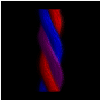
by Eduard Gröller, René Rau, Wolfgang Straßer
project duration: 1995-1996
This is a short description of a project that was done during a teaching and research visit of the first author at WSI-GRIS (University of Tübingen), Germany, dealing with the photorealistic rendering of virtual textile fabrics.
Knitting yarns are made of twisted subyarns which themselves consist of microscopic fibres. Single fibres are not visible individually but contribute to the visual impression of the yarn structure. Yarns are therefore modeled as volume data where density values correspond to fibre frequencies.
Knitting patterns are typically characterized by a simple repetitive structure. Two types of stitches (plain stitch and reverse stitch) are used to produce such knitting patterns. Thus for a realistic simulation the knitting pattern is subdivded into basic elements as given in the following image.
The course of a knitting thread is modelled within such basic elements as 1D curve. A 2D thread cross section (density map) is moved along this 1D curve to produce the volume data set which represents a single basic element. The twisted shape of yarns is taken into account by rotating the thread cross section around the 1D curve.
Rendering of simple knitting patterns is done by volume visualization of the basic elements. In a subsequent step the resulting images are combined to give an image of the entire knitting pattern. Close-up views show that the 3D microstructure of knitwear is generated much better with our approach than 2D texture mapping techniques, an alternative approach, would produce.
The results achieved compare favorably (at least in our opinion) with scanned versions of real knitting patterns.
Here are some further computer-generated images:
Additional information and extensions:
Links to other sites with research on knitwear, textiles:
This page is maintained by Eduard Gröller. It was last updated on November 20, 1998.
If you have any comments, please send a message to edi@cg.tuwien.ac.at.